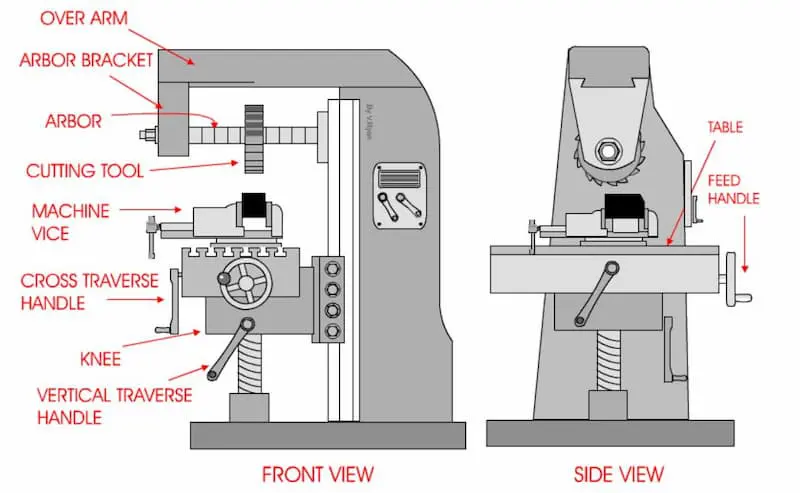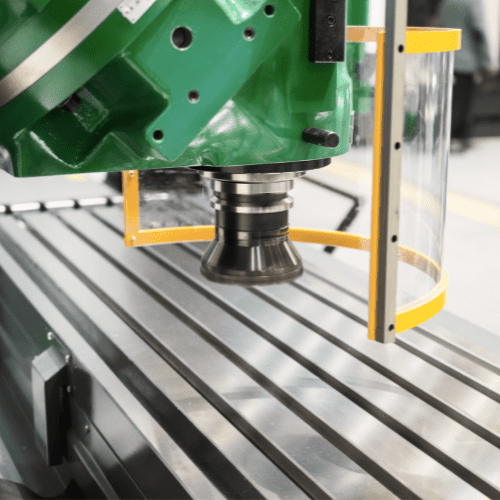What’s the difference between horizontal and vertical milling?
According to Fractory:
Milling refers to the removal of workpiece material by rotary cutters. Grooving, boring, drilling, etc. can all be used to manufacture parts with the desired finish.
The introduction of CNC added many useful features to milling. For example, the CNC program runs the automatic tool change system, pallet changer, tool carousel, enclosures, and coolant systems. The setup with these extra features now came to be known as a machining centre.
With time, turning capabilities became a part of these machining centres. The machining industry started referring to them as multitasking machines. Thus, modern milling machinery can mill as well as perform lathe machine jobs for plate metal fabrication.
Types of Milling Machines
The metal fabrication industry uses different types of milling machines depending upon the application. Broadly, we classify them as horizontal and vertical milling machines.
There are many differences between vertical vs horizontal milling but before we get to that, let’s take a brief look at what each of these mills is like.
Vertical milling machines

In vertical mills, we fix the workpiece on a bed and carry out machining by a movable tool. The tool removes the material as needed by following the CNC instructions.
There are two main types of vertical milling machines – turret mills and bed milling machines.
Turret milling machines
In a turret mill, the vertical spindle remains fixed while the bed portion can move horizontally as well as vertically according to the program. A turret mill usually works on a small part.
Bed milling machines
In a bed mill, the bed can only move in the horizontal direction whereas the spindle moves up and down as needed. These machines are better for bigger workpieces.
Horizontal milling machine

In horizontal milling machines, the part is again fixed on the bed. The machining takes place horizontally or at a required angle if the machine is equipped with a universal table.
This table allows the cutting head to approach the workpiece from a variety of angles.
The machine may also be equipped with special cutters to machine bevels, gears, radii, and grooves. Simplex horizontal mills have one spindle, while duplex has two.
Horizontal vs Vertical Mill
While there are many similarities between the two milling equipment, there are also many differences. We shall now look at the difference between them when it comes to their some important characteristics.
Orientation
One of the primary differences between the two is the way the tools interact with the workpiece. As the name suggests, in horizontal milling machines, the orientation of the spindle on which the cutting tool is fixed is horizontal. The rotary cutter digs into the surface and removes material from the workpiece while rotating about this horizontal axis.
In a vertical mill, the tool is fixed in a vertical orientation. Featuring a setup similar to a bench drilling machine, these machines have a vertical arbour that holds as well as rotates the cutting tool plunging it deep into the workpiece material as needed.
Tool geometry
The shape and specifications of milling cutters and tools for the two types of machines are different. Horizontal milling machines feature short and thick tools capable of removing large amounts of material from the workpiece compared to the vertical milling machine.
Vertical milling machines feature long and thin tools. The difference in cutting tool geometry affects the nature and accuracy of the cuts each machine is capable of.
Cut specifications
Due to the thick tools used in horizontal milling, they are capable of performing deep and heavy cuts faster. In addition to normal cuts (facing, chamfering, etc.) they are ideal for grooving and slotting operations.
Vertical milling machines can perform most general tasks but plunge cuts and drilling on the workpiece are their specialities. A vertical milling machine also offers higher accuracy compared to a horizontal milling machine.
Cost
Vertical milling machines cost less compared to horizontal milling machines. The smaller investment cost means more and more machine shops employ vertical machining centres. The cost of operation and maintenance is also less. These production cost savings reduce the overall machining cost for the customers.
Due to the higher number of vertical machining centres in the industry, the number of skilled operators for these machines is also high.
While horizontal milling machines cost more than their vertical counterpart, they make up for it by having better time and production efficiency in the long run. Only well-established manufacturing companies that have been in the business for some time invest in horizontal milling machines.
Which Is Better?
While both vertical and horizontal machining centres are capable of handling many similar cuts, there are certain other cuts that only each type can handle.
Besides that, other factors that influence the choice between the two machines are:
The accuracy of the cut
When there is a greater need for accuracy, we prefer vertical machining centres over horizontal ones.
Material removal rate
For applications that need more material removal from the workpiece, horizontal machining is preferred as it can machine bigger cuts at the same cutting tool speeds in the same amount of time.
Number of planes/sides for machining
Vertical milling machines are a better option when the machining is to be carried out on a single plane. When multiple sides need to be machined at varying angles, we use horizontal milling machines.
Extent of customisation
While each type of milling machine can work with a variety of tools, the horizontal milling machine is far more customisable than the vertical one. In fact, certain add-ons and cutting heads enable a horizontal mill to function as a vertical mill.
This works great for manufacturing companies that only have a horizontal machining centre to perform jobs that can be done only on vertical mills.
Conclusion
Milling machines have advanced rapidly in the last two decades. They provide ease in creating machine parts besides providing other production benefits.
Modern vertical and horizontal milling complement each other beautifully and knowing the contrast between the two is crucial to make an informed choice. The information available in this post should put you in a better position to do the same.






